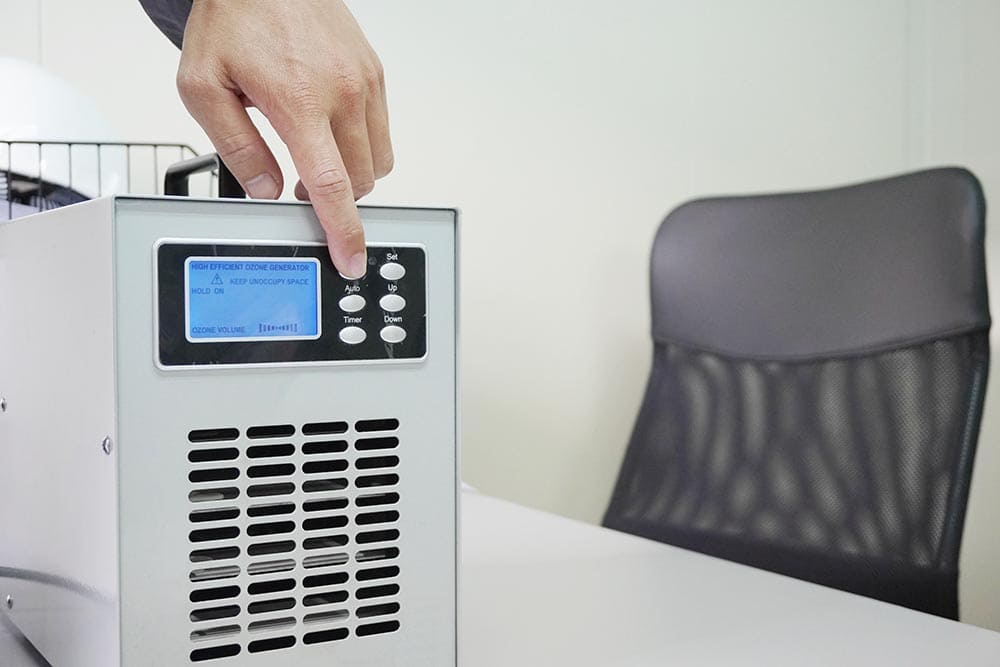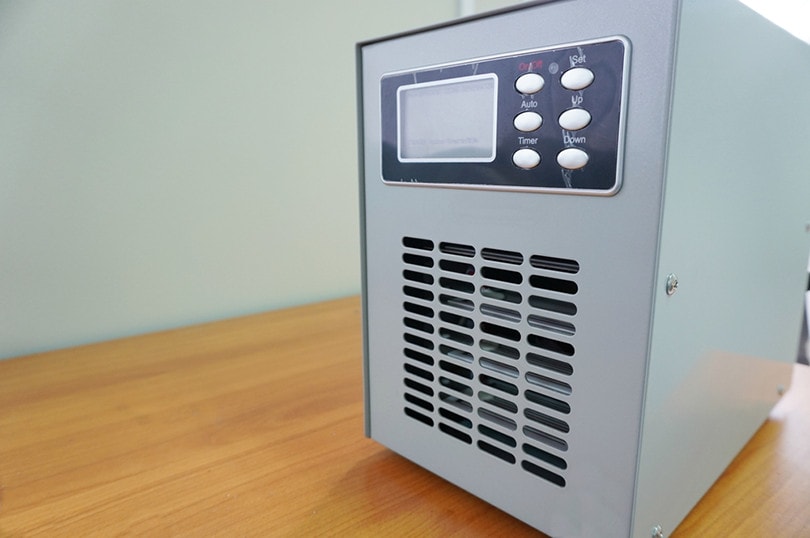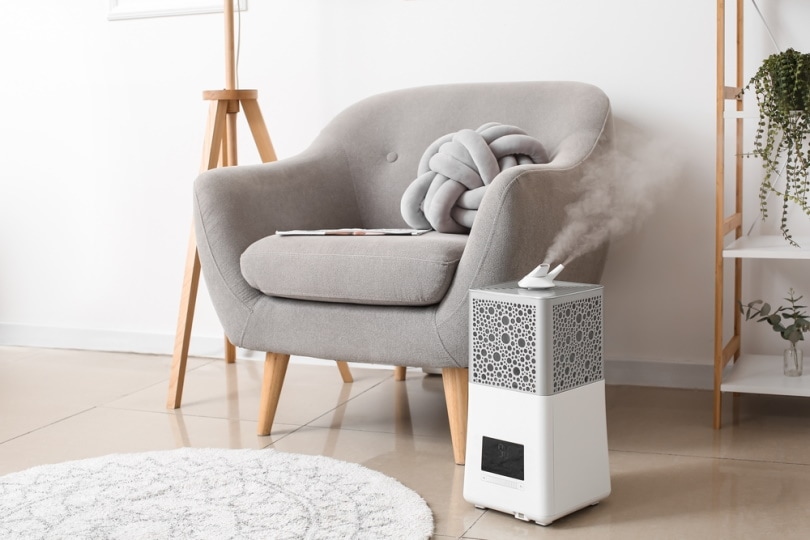What Is an Ozone Generator? Functionality & Safety
-
- Last updated:

Ozone generators may have been around since the time of Nikola Tesla, but their popularity as air freshening devices grew significantly during the COVID-19 Pandemic. These devices are normally advertised as air purifiers capable of removing airborne contaminants and odors from occupied spaces.
Unfortunately, there is a lot of debate about the safety of using ozone generators. Some claim that these products are not only ineffective at cleaning the air, but they pose serious health hazards to animals and humans. However, the proponents claim that the device can clean indoor air, and some brands say that their products are approved by the federal government.
Despite these debates, what makes ozone generators effective at cleaning indoor air also makes them dangerous. Moreover, the federal government has not approved the use of these devices1 in closed spaces.
In this article, we will discuss what ozone generators are, and how they work. We will also investigate the effectiveness of air purification and the reasons why it should be avoided.

How Do Ozone-Generating Air Cleaners Work?
Ozone generators are air cleaning devices often advertised as effective at cleaning odors and air contaminants in a room. During the Covid 19 pandemic, these devices were popularized as the need to have clean air in occupied spaces increased.
Also, different brands often market their ozone healthy air, pure air, or even energized oxygen. Most published scientific journals claim that small concentration of ozone gas is safe to breathe but will not be enough at purifying indoor air.
In basic terms, these devices work by producing enough electricity to combine oxygen atoms creating ozone. They produce a charged zone that attaches to odor-creating microbes in the air. In nature, ozone is created by lightning and UV light. Air purifiers use the two same basic principles.
Is It Safe?
Ozone is a very dangerous gas known to have adverse effects on the body. Whether in its pure form or mixed with other chemicals, it can be harmful to your health. This is because ozone is made up of three oxygen atoms. Two of the atoms make the basic oxygen molecule. The third atom is highly reactive and makes ozone an unstable gas. When inhaled, it causes irritation in the throat, eyes, nose, and lungs. These negative effects are the reason why different governments have standards against the usage of ozone generators.

How Effective Are Ozone Generators?
As you may have realized, the EPA, FDA, and the CDC also warn against the dangers of using ozone generators. Why are these products still retailing in local stores? Sure, manufacturers and vendors claim that ozone generators are safe and effective air purifiers. What’s more, they not only absorb air pollutants like other air purifiers, they destroy all pollutants in the vicinity.
However, there is a lot of evidence that these products can be harmful to our bodies, so what justifies the need to purchase one?
Claims by Manufacturers
Most manufacturers support their products by saying that the reactive nature of ozone gas allows it to attach to pollutants. These pollutants are often organic matter such as viruses, mold, bacteria, and odorous things like smoke. However, this theory is not backed up by sound evidence or science.
Effectiveness Against Organic Compounds
There is a lot of scientific evidence that claims ozone is capable of destroying organic matter like viruses and bacteria. However, to do that, you need high concentrations of ozone.
Effectiveness Against Violent Organic Compounds (VOCs)
Many people often wonder about the effectiveness of ozone at destroying VOC contaminants in a room. Unfortunately, ozone generators will not remove VOCs, unless you wait for thousands of years.

Effectiveness Against Allergens
Unlike typical air purifiers, ozone generators never remove particulates such as pollen, dust, and dirt from the air. In theory, these products should be able to purify a room by removing allergens, but since these particulates are not living organisms, they cannot be destroyed. So, based on available scientific reports, it’s hard to state whether ozone is effective at killing allergens like pollen.
Effectiveness Against Odors
As earlier mentioned, standard air purifiers are only effective at removing solid particles. However, since odors are in gaseous form, it might be difficult. Most filters feature granular charcoal to absorb odors from a room.
On the other hand, ozone generators can, in theory, remove cooking oil smell, cigarette smoke, and most VOCs. This is because ozone gas attaches itself to pollutants, thus destroying them. However, this theory is not popular among the scientific community, so there are not a lot of studies done regarding its effectiveness.
EPAs Verdict about the Effectiveness of Ozone Generators
After reviewing various scientific studies, the EPA concluded that the concentration that meets health regulations and standards would not be effective at destroying contaminants in indoor air. So clearly, ozone generators create more problems than they can fix, and as such, it’s an unwise investment.
They also found out that the chemical reaction required for ozone gas to be effective requires years to happen. So, unless you want to run your ozone generator for months in an unoccupied building, its usefulness is in doubt.
In addition, once the chemical reaction takes place, chances are high that the generator will produce irritating substances. For instance, in one of their studies, when ozone was combined with pollutants in a carpet, the gas removed the smell of other substances but also produced aldehydes, which are considered toxic to humans.

The 4 Reasons Why You Should Avoid Ozone Generators
As you may have gathered, not only are ozone generators ineffective at air purification but they are dangerous to human health. Once inhaled, the gas can cause coughing, chest pains, throat irritation, and shortness of breath. They can also inhibit the body’s ability to fight a respiratory infection and even worsen diseases like asthma. Here are other reasons why you should avoid Ozone generators to purify the air in occupied spaces.
1. They May Not Even Work
Even though some manufacturers market their ozone generators as safe and effective at making contaminants in your home harmless, this is entirely false. It is a misleading marketing gimmick because scientific research shows that for the device to eradicate air contaminants in your home, the chemical reaction might take years. Other studies also found that ozone is ineffective at removing carbon monoxide. Also, if used at concentrations recommended by the EPA, ozone will not be effective at killing biological pollutants.
2. They Do Not Remove All Particulates

Another discouraging factor about ozone generators is their inability to remove particulates such as pollen, dust, and dirt from indoor air. To fix this, some manufacturers equip their generators with an ionizer that removes negatively charged ions from the air. However, according to recent studies, ionizers are less than effective at combating air-borne pollutants if compared to electrostatic precipitators and HEPA filters.
3. Chemical Reactions in the Ozone Generator Are Dangerous
Even if Ozone generators were effective at removing chemicals from indoor air, the chemical reaction could have nasty side effects on humans. When ozone reacts to these chemicals, the by-products are very harmful. This is common with plastic products such as wallpapers and carpets.
So, while the reaction will reduce the target chemicals, the dangerous by-products will render the whole process counter-productive.
4. Exposure to Ozone Gas
As many scientific studies suggest, it is hard to determine the level of ozone concentration in a room because a lot of factors come into play. The concentrations are likely to be higher if you use a big generator in a small space.
The concentration will also be affected by whether the doors and windows are open or closed during the chemical reaction. Some other factors include outdoor air ventilation, the number of furnishings and materials in a room to react with the ozone gas, and the proximity of your body to the generator.

Safety Precautions When Using an Ozone Generator
Ozone generators are recommended for unoccupied rooms and when pets and people are not present. While high concentrations of Ozone can help deal with odors, long-term exposure to the gas can be detrimental to your health.
These are valid concerns because ozone works by reconfiguring materials on a molecular level as part of the oxidation process. However, since humans and pets are not made from molecules, exposure to high concentrations can lead to respiratory irritations, especially for people with underlying diseases like COPD and asthma.
That said, there are other safety precautions you can take to protect yourself from the effects of ozone exposure in occupied spaces. Keep in mind that different ozone generators have their features and characteristics. However, if you have never used an ozone generator before, make sure you follow the safety tips outlined below.
Plenty of Ventilation
Before using an ozone generator, ensure there is a free flow of air from the outdoors. You can simply achieve this by opening windows and doors in our room. You can also ventilate an occupied area by utilizing exhaust fans near the source of the pollutant, usually above your stove while cooking. Also, you can install a mechanical ventilation system if your room is not sufficiently ventilated
Remove Indoor Pollutants Before Activating the Ozone Generator
Before purchasing an indoor ozone generator, try removing indoor polluting sources from your home. You can do this by limiting the number of pollutants, restricting smoking to outdoor areas, sparingly using candles and incense in your house, and maintaining wood and gas-burning appliances. Also, ensure frequent cleaning to reduce dust and dirt buildup.

Regular Maintenance of the Ozone Generator
As a rule, clean and change the collecting plate after every 2–6 months to keep it functional and in great condition. So always check for dust and grime on your plate especially if you are a habitual user. They will reduce the device’s durability and performance.
Avoid High Humidity Areas
Try limiting the machine’s usage in high-humidity areas. This often leads to the softening and dampening of the arcing inside the device. However, you can run the generator in a chilly or warm environment.
Do Not Use the Machine in a Room Occupied By People and Pets
Whenever you activate the ozone generator, ensure the room is unoccupied for some time. If you must purify the entire house, you better find alternative means of lodging until it is safe to come back.
Always wait for at least 4 hours before re-entering a purified room. Normally, it takes about 30 minutes for the ozone gas to settle down after shutting off the generator. However, to be on the safe side, wait for at least 4 hours for the ozone to turn back into oxygen.
Set a Shutdown Timer
Most modern ozone generator varieties are equipped with an inbuilt timer that automatically shuts down the device when time runs out. If you don’t have a timer, always cover your nose and mouth as you manually shut it off.
Remove or Cover Valuable Items in Your Room
As mentioned above, ozone reacts with different materials in the room being purified. Materials such as paper and metal do not particularly react well to ozone gas. So, remove them from the room or cover larger items with a blanket if you can.

What Is the Safer & More Effective Alternative to Ozone Generators?
Clearly, ozone generators are dangerous and ineffective at removing air pollutants and odors from an occupied building. So, how else can you safely purify the air inside your home? Well, a HEPA filter is a safer and more effective solution for air purification compared to an ozone-producing device. These filters function by trapping indoor polluting agents instead of attaching to them through a chemical reaction.
These are the only air cleaning devices that meet EPAs safety standards. Therefore, if you purchase an air purifier that uses this type of technology, you can rest assured that you are safe even when reducing air pollutants from your home.
Sometimes, HEPA filters are combined with other technologies like activated carbon to improve efficiency. When combined this technology can remove chemical, gaseous, and solid pollutants from the air and improve your indoor air quality.

Frequently Asked Questions (FAQs)
What Does Ozone Smell Like?
Like most gases, ozone is colorless. However, when produced in a room in low concentration, it usually develops a smell often described as sweet and pleasant. Most people say that it smells like fresh morning air in the mountains.
How Long Should You Run an Ozone Generator in a Room?
This will depend on the size of your room as well as the type of ozone generator. However, you can run the device for between 3–10 hours. For your entire house, ensure that you have up to 30 hours of continuous operation in an attempt to remove pollutants from indoor air.
How Long Does It Take for Ozone to Dissipate?
This will also depend on factors such as temperature, dust, and room size. For the oxygen to dissipate at lower concentration levels, it will take between 30 minutes to 2 hours for oxygen to break down to breathable oxygen. At high concentration, it will take 3–4 hours. So, wait at least 4 hours after shutting off the machine before walking back into the oxidized room.

Conclusion
An ozone generator is a type of air purifying machine that helps remove odors and contaminants from the air. They can be helpful air purifiers, especially for areas that have been uninhabited for a long time. However, these machines are not a safe or effective way of cleaning the air in occupied spaces.
Fortunately, you can safely and effectively clean indoor air by utilizing HEPA filter technology. But if you absolutely must use ozone generators, make sure your room is well ventilated, precious items are covered or removed and you wait for at least 4 hours before re-entering the purified room. Finally, if you notice that your eyes and mouth are irritated after using the machine, seek immediate medical attention.
Featured Image Credit: Red_Shadow, Shutterstock
Contents


